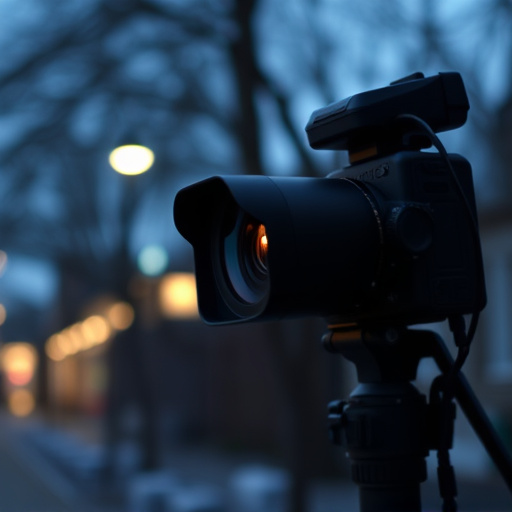Small hidden cameras designed for bedroom surveillance have evolved into advanced, discreet monitoring solutions that blend seamlessly with home decor. With compact size, motion detection, night vision, and wireless connectivity, these cameras allow remote monitoring via smartphone apps, offering peace of mind and enhanced security. Detecting RF signals is crucial in identifying such cameras; an RF detector sweep pinpoints devices emitting waves for transmitting footage or communicating with external devices. Preparation for scanning includes decluttering, moving furniture, and understanding the detector's functions. By scanning high-risk areas and verifying signals, users can effectively detect small hidden cameras in bedrooms, ensuring safety and privacy.
Uncover the secrets hidden within your bedroom with this comprehensive guide to detecting small hidden cameras using an RF detector sweep. In today’s digital age, privacy is paramount, especially in intimate spaces. This tutorial equips you with the knowledge to identify clandestine surveillance devices, ensuring your personal moments remain secure. Learn how to navigate the landscape of RF signals and employ effective strategies for locating tiny hidden cameras, becoming your own guardian of privacy.
- Understanding Small Hidden Cameras for Bedroom Surveillance
- Detecting RF Signals: The Basics of an RF Detector Sweep
- Preparing for the Camera Detection Process
- Step-by-Step Tutorial: Uncovering Hidden Bedrooms Cameras Using an RF Detector
Understanding Small Hidden Cameras for Bedroom Surveillance
Small hidden cameras, especially those designed for bedroom surveillance, have evolved significantly in recent years. These compact devices offer discrete monitoring solutions that fit seamlessly into your home decor while providing peace of mind and security. Their miniature size allows them to be placed almost anywhere—from corners of rooms to behind pictures or inside bookshelves—making it challenging for intruders to spot them.
These cameras are often equipped with advanced features like motion detection, night vision, and wireless connectivity, enabling users to monitor their bedrooms remotely via smartphone apps. This level of convenience and surveillance is particularly appealing for homeowners seeking to protect their personal spaces and ensure the safety of their families.
Detecting RF Signals: The Basics of an RF Detector Sweep
Detecting RF (radio frequency) signals is a crucial step in identifying and locating small hidden cameras, especially those designed to be discreet, like those suitable for bedrooms. An RF detector sweep is a non-invasive method used to pinpoint devices emitting radio waves, which many modern hidden cameras do to transmit footage or communicate with external devices.
By tuning your RF detector to the right frequency range, you can intercept these signals, revealing the presence of a hidden camera. This process involves scanning through different channels or frequencies to detect any consistent emissions, which could indicate an active device. Understanding the basics of RF detection and sweep techniques is essential for anyone aiming to protect their privacy from such sophisticated surveillance equipment, like small bedroom hidden cameras.
Preparing for the Camera Detection Process
Before beginning the RF detector sweep, it’s crucial to prepare your space and mindset for a thorough inspection. For those looking to detect small hidden cameras in bedrooms, this process becomes even more sensitive. Start by decluttering your bedroom, moving furniture slightly, and checking common hiding spots like behind mirrors or under bedding. Ensure you have all necessary tools: an RF detector, spare batteries, and a notepad to record findings. Familiarize yourself with the detector’s functions and range.
A successful detection requires patience and a methodical approach. Plan to sweep the room systematically, covering every corner. Remember that small hidden cameras for bedroom use often operate on specific frequencies, so understanding your detector’s capabilities will help you identify potential sources accurately.
Step-by-Step Tutorial: Uncovering Hidden Bedrooms Cameras Using an RF Detector
Uncovering hidden bedrooms cameras using an RF (radio frequency) detector is a practical method to identify small hidden cameras, often used in intimate spaces like bedrooms. Here’s a step-by-step guide for your safety and privacy:
1. Prepare Your Tools: Begin by gathering essential tools – an RF detector, batteries (if required), and protective gear. Ensure the detector is calibrated and ready for use, following the manufacturer’s instructions. Wear gloves or hold the detector with a cloth to avoid leaving fingerprints that might interfere with results.
2. Scan Potential Areas: Start with high-risk zones like corners, behind furniture, or near electrical outlets where small hidden cameras are commonly concealed. Hold the RF detector close to the surface you’re scanning, observing the readings on the detector’s display. Sudden spikes in the reading indicate a potential source of radio interference, which could be a hidden camera transmitting signals.
3. Identify and Verify: Once an area with a significant reading is identified, move slowly and carefully around it, keeping the detector close to the surface. Verify if the readings fluctuate or remain high, indicating the presence of active equipment. Small hidden cameras emit unique radio signals, making them detectable by RF detectors.
4. Investigate Further: If a strong signal persists, consider using additional tools for confirmation. This might include infrared (IR) cameras or static electrical field sensors, depending on the specific type of hidden camera you suspect. These methods can help pinpoint the exact location and type of device.
Uncovering hidden cameras in your bedroom can be a sensitive yet crucial task. By understanding the basics of radio frequency (RF) signal detection and employing the right tools, such as an RF detector, you can effectively navigate this process. This tutorial has guided you through preparing for and executing an RF detector sweep, enabling you to identify and mitigate potential privacy breaches caused by small hidden cameras in your bedroom. Stay vigilant and secure your personal space with these essential steps.
